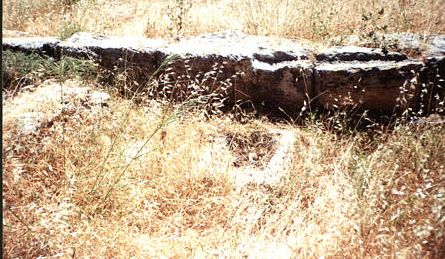Pictures and details courtesy of world traveler Bob Cromwell
Mr. Cromwell has spent many hours dedicated to documenting world toilet conditions and has spent a “fair amount” of time in west Asia, including eight trips to Turkey, a few trips to Syria, Cairo-to-Istanbul overland, etc. He has given us written permission to post his photos and information here.
We would love if you would share your toilet pictures and experiences from around the world with us. Please recognize that Mr. Cromwell experienced some very nasty toilets in some countries but that is not a reflection that all toilets in those countries are all that bad. We are sure that there are many wonderful (and unique to U.S. standards) toilets in every country (and if you can share them with us we will gladly show/share them here).
Imperial Toilets

This is the toilet of the Padishah Emperor, the Sultan of the Ottoman Empire, the ruler of all the Middle East, northern Africa, and southeast Europe. This is in the harem, the private quarters of the sultan, in Topkapi Palace in Istanbul, Turkey. There’s a board over the hole, note the fine marble and craftsmanship.
Ottoman Toilets

These toilets are representative of mid to late Ottoman Empire design, and show the Ottoman tendency to include ornate design details in the most utilitarian of objects. These toilets are on exhibit at the Museum of Underwater Archaeology, in Bodrum, Turkey.
Crusader Toilets

Tamerlane invaded Anatolia in 1402, reducing the control of the Ottoman Empire over south-western Anatolia. The Knights Hospitalier, a.k.a. the Knights of Saint John of Jerusalem, built the Castle of Saint Peter at Helicarnassus, Asia Minor (now Bodrum, Turkey). These are their toilets.
Biblical Toilets

Pit toilet constructed from local rubble, just below the summit of Mount Sinai, Egypt. Not actually from the era of Moses, thought to be approximately 1450 BC, but the mountain has been a major pilgrimage site at least since when the Byzantine Empress Helena (ruled 313-328 AD) established a monastery at the base of the mountain.


This category of toilet generally means public ones of Greek design. These were communal — no private stalls, but instead several closely adjacent seats on long benches. The flat-topped bench was executed in a variety of materials, although marble highly polished through use was perhaps the most elegant. In the bench you find one horseshoe shaped hole per “station”. Below the bench was a channel for carrying away wastes. The channel varies widely in depth from one site to the next. Immediately in front of the bench was a shallow channel carrying (relatively) clean flowing water for washing one’s hands. Compare this to the copper tube on the modern Turkish train toilet.
Nice marble-topped public toilets near the Library of Celcius, in Ephesus, Asia Minor (Turkey). This large public toilet had approximately twelve seats on each of three sides of a room, so it was a 36-holer! Well, Ephesus was the major city of Asia Minor. It also has a remarkably deep waste channel, from about two meters deep (in the section shown at right here) to perhaps twice that on the other side of the room. Note how far the water channel is in front of the seat, one would have to lean very far forward to utilize it. These toilets date from when Luke, Paul, John, et. al. were in Ephesus. The wealthy Ephesians would send their slaves down early to warm up a seat for them. A luxury the apostles didn’t have.



Much rougher marble public toilets next to the main processional way from the harbor gate, in Korinthos, Greece. These also date from when Paul was here, attempting to turn people away from the mountaintop debauchery at the Temple of Aphrodite, visible on the mountaintop in the distance. Presumably, the toilets were better enclosed back then.
Ancient Non-Biblical Toilets

With the Asclepion dating from about 400 BC, these admittedly rudimentary ruins are the oldest toilets documented on this page (well, unless Moses really built that one near the summit of Mount Sinai, shown above). The Asclepion was in use until 540 AD, so with 940 years of sick people these saw a lot of use….




